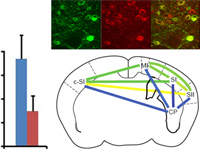Fast-conducting myelinated high-threshold mechanoreceptors (AHTMR) are largely thought to
transmit acute nociception from the periphery. However, their roles in normal withdrawal and
in nerve injury–induced hyperalgesia are less well accepted. Modulation of this subpopulation
of peripheral neurons would help define their roles in withdrawal behaviors. The optically
active proton pump, ArchT, was placed in an adeno-associated virus-type 8 viral vector with
the CAG promoter and was administered by intrathecal injection resulting in expression in
myelinated neurons. Optical inhibition of peripheral neurons at the soma and transcutaneously
was possible in the neurons expressing ArchT, but not in neurons from control animals.
Receptive field characteristics and electrophysiology determined that inhibition was neuronal
subtype–specific with only AHTMR neurons being inhibited. One week after nerve injury the
AHTMR are hyperexcitable, but can still be inhibited at the soma and transcutaneously.
Withdrawal thresholds to mechanical stimuli in normal and in hyperalgesic nerve-injured
animals also were increased by transcutaneous light to the affected hindpaw. This suggests
that AHTMR neurons play a role not only in threshold-related withdrawal behavior in the
normal animal, but also in sensitized states after nerve injury. This is the first time this
subpopulation of neurons has been reversibly modulated to test their contribution to
withdrawal-related behaviors before and after nerve injury. This technique may prove useful
to define the role of selective neuronal populations in different pain states.
